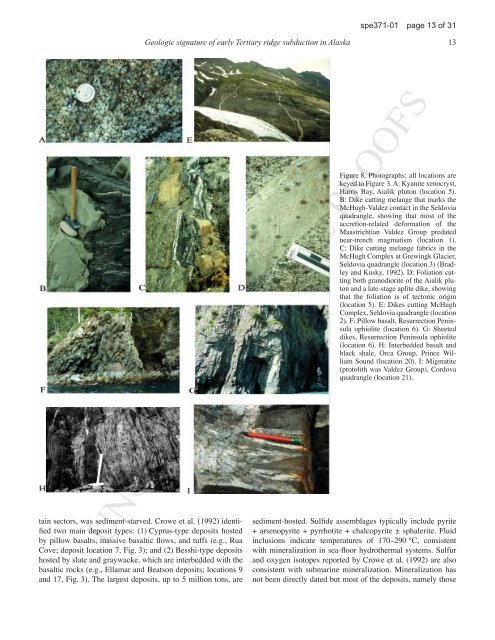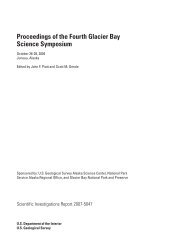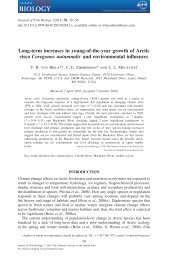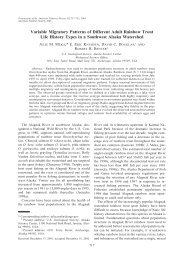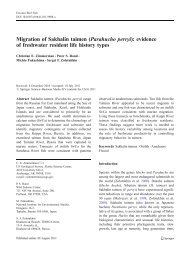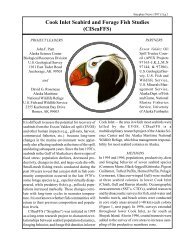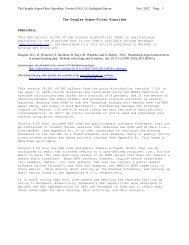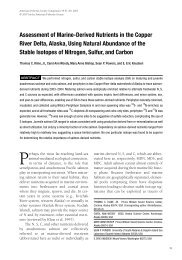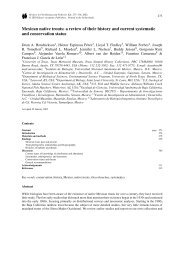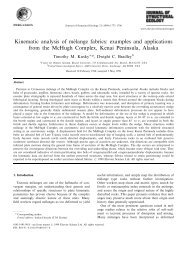UNCORRECTED PAGE PROOFS - USGS Alaska Science Center
UNCORRECTED PAGE PROOFS - USGS Alaska Science Center
UNCORRECTED PAGE PROOFS - USGS Alaska Science Center
You also want an ePaper? Increase the reach of your titles
YUMPU automatically turns print PDFs into web optimized ePapers that Google loves.
spe371-01 page 13 of 31<br />
Geologic signature of early Tertiary ridge subduction in <strong>Alaska</strong> 13<br />
tain sectors, was sediment-starved. Crowe et al. (1992) identi-<br />
Þed two main deposit types: (1) Cyprus-type deposits hosted<br />
by pillow basalts, massive basaltic ßows, and tuffs (e.g., Rua<br />
Cove; deposit location 7, Fig. 3); and (2) Besshi-type deposits<br />
hosted by slate and graywacke, which are interbedded with the<br />
basaltic rocks (e.g., Ellamar and Beatson deposits; locations 9<br />
and 17, Fig. 3). The largest deposits, up to 5 million tons, are<br />
Figure 8. Photographs; all locations are<br />
keyed to Figure 3. A: Kyanite xenocryst,<br />
Harris Bay, Aialik pluton (location 5).<br />
B: Dike cutting melange that marks the<br />
McHugh-Valdez contact in the Seldovia<br />
quadrangle, showing that most of the<br />
accretion-related deformation of the<br />
Maastrichtian Valdez Group predated<br />
near-trench magmatism (location 1).<br />
C: Dike cutting melange fabrics in the<br />
McHugh Complex at Grewingk Glacier,<br />
Seldovia quadrangle (location 3) (Bradley<br />
and Kusky, 1992). D: Foliation cutting<br />
both granodiorite of the Aialik pluton<br />
and a late-stage aplite dike, showing<br />
that the foliation is of tectonic origin<br />
(location 5). E: Dikes cutting McHugh<br />
Complex, Seldovia quadrangle (location<br />
2). F: Pillow basalt, Resurrection Peninsula<br />
ophiolite (location 6). G: Sheeted<br />
dikes, Resurrection Peninsula ophiolite<br />
(location 6). H: Interbedded basalt and<br />
black shale, Orca Group, Prince William<br />
Sound (location 20). I: Migmatite<br />
(protolith was Valdez Group), Cordova<br />
quadrangle (location 21).<br />
sediment-hosted. SulÞde assemblages typically include pyrite<br />
+ arsenopyrite + pyrrhotite + chalcopyrite ± sphalerite. Fluid<br />
inclusions indicate temperatures of 170–290 °C, consistent<br />
with mineralization in sea-ßoor hydrothermal systems. Sulfur<br />
and oxygen isotopes reported by Crowe et al. (1992) are also<br />
consistent with submarine mineralization. Mineralization has<br />
not been directly dated but most of the deposits, namely those<br />
<strong>UNCORRECTED</strong> <strong>PAGE</strong> <strong>PROOFS</strong>


